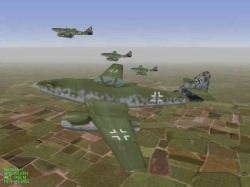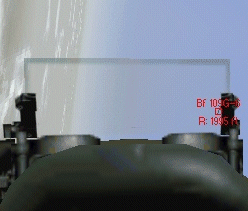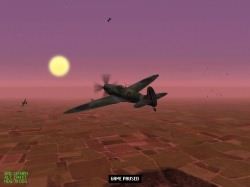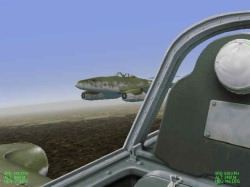By: Jim 'Twitch' Tittle
Date: 1998-11-22
"Meat on the table," is what Thunderbolt ace Bob Johnson called the Me 110. ("Me" because that's what aces of the time knew them as, not "Bf".) The rear gunner squirts a feeble stream of seven point nines vaguely in your direction as your .50's get him smoking good from 300 yards. You touch the trigger again and he disintegrates into a big ball of flame. Your wingman congratulates you as you bank away to avoid the pieces, searching for another victim.
WWII IS BACK!
You'll experience the above scenario, and much more, in Microprose's European Air War. All the heavy metal is there too. Fly-able is the P-38H & J, P-47C & D, P-51B & D, Hurricane I, Spitfire Ia, IX & XIVE, Typhoon IB, Tempest V, Fw 190A8 & D-9, Bf 109E-4, G-6 & K-4, Bf 110C & G, plus the Me 262. (See Jim's earlier article on the aircraft of EAW).
Bombers you will meet are the B-17, B-24, B-26, Mosquito, Ju 87, Ju 88, He 111, plus the V-1's. Some of these aircraft have never before been modeled in a simulation. Even if they have, it's never been this good. This is what all of the World War II air combat fans have been waiting years for.
GRAPHIC IMAGES
First, but not foremost, is the graphics. I compare previous WWII sims such as Secret Weapons of the Luftwaffe, Aces Over the Pacific, Aces Over Europe and Pacific Air War's graphics to Warner Brothers cartoons. Everything is defined and clear enough but it's all like a neatly done coloring book. Color is brighter and every line of every object in the air and on the ground is totally distinct.
EAW is more like a well illustrated comic book. It is not cartoonish yet not photographic quality either. More realistic, it leans towards a fine, detailed aviation oil painting by Stan Stokes or Roy Grinnell. Paint schemes are immaculate showing weathering and wear. Squadron markings are good enough in detail to be recognizable. Everything looks right.
I personally do not want too much terrain detail. After you fly over a few times and "gee whiz" about it, it's just ground clutter when you're trying to pick up that 109 turning at 10 o'clock low. EAW does quite well in this respect. As you focus on the gray camo 109G clearly, the surrounding realistically blurs away.

Me262-A1 flight scrambles to intercept the
heavies.
VIEWING ROOM
Simulation designers have a tough job in creating views. Nothing is like turning your head and moving your eyes in a real cockpit. We must rely on punching view controls or padlock an object.
The padlock will project the object chosen on the screen, no matter which direction it is relative to the way you are flying. Disorienting at first, you can practice and soon coordinate your stick and rudder moves to line up the enemy plane in the sight ring. It is the nearest thing there is to natural, reflex, line of sight viewing.
One good crutch is the target info that brackets the on-screen object with range, aircraft type and heading. Altitude and speed read out on an unobtrusive HUD at the lower right of the screen. Jet sims have used it for ages in target acquisition at long ranges. You can select the amount of info displayed over a given target.
I can rationalize this aid because in reality you can see so much better at WWII combat ranges than off of the dumb monitor screen. Your 17-19" screen is about the size of an open comic book, and you're doing a "where's Waldo" on the pages. Next time you're really in a 737 descending at 5,000 feet going 250-300 mph, note how much detail your eyes take in. No contest.
I can tell you that, with perfect clarity, you will see an aircraft traversing the screen at 1/4 mile away. As with all of European Air War's features, if you do not like them, you can turn them off.
Over all the view dynamics are really fine. You immediately get the "big sky" sensation. The old WWII sims took in a scope of about a mile around your A/C, aircraft. EAW can make you feel very alone in the sky, taking in tens of miles of view at a time. Read any combat narrative and pilots relate the same feeling.
Target tracking left on will read out to 500,000 feet behind you! Weather effects are nicely done. Chasing a 109 over France in a P-47C you'll find yourself slipping in and out of wispy, low marine layers of coastal clouds. The haze on the horizon is perfectly real.
The size of the enemy aircraft is a tough to model to suit all. The plane is larger at all ranges than previous WWII simulations but I believe that some will still find them small. You can use the "+" key to zoom in from 700 yards with .50 caliber and 20 millimeter being deadly. Input through the joystick is amplified during zoom so slight movements are the order. The orange tracers guide you without being too bright.

B-17 limping along on 2 running engines
SHOOT TO KILL
The two settings for gunnery are "easy" and "realistic." At killing range of 200-300 yards an E/A, enemy aircraft in a smooth turn is VERY hard to hit in "realistic." On "easy" it seems more real to me as you see errant strikes noted with flashes and smoke puffs as the A/C is lightly hit. When you are missing solid hits the few rounds that are in the vicinity give you hints for adjusting.
I've heard many pilots speak of this. In "realistic" you just plain miss. At six o'clock it seems about the same on either setting. Few planes have ammo rounds counters and you must be prudent with your ordnance, like real. Quick bursts squeezed off are the only way to excel. One neat, realistic feature is the gun feed stoppage you randomly get on a weapon. Flying through bomber debris in the Me 262 put all my 30mm's out of action once.
Weapon sounds are a bit puny for my taste relative to the engine sounds. The four .50's on the P-51B sound about like the eight on the P-47. The 30mm is a nice thumper so best turn it all up to savor all the audio.
TORQUE IT UP
The engine sounds are generally good and are distinctive to each plane. I expected a more characteristic roar when adding full throttle and dumping a quart of simulated av gas into the cylinders. Throttle response leading to acceleration may or may not suit you. It's a difficult area to model so that everyone will like it.
Torque effects can be turned on and off. The "on" setting will give a tendency to roll around the center axis and countering this with opposite rudder, as combat pilots did, does not correct it. You must use the ailerons. Uncharacteristically, you fight to hold a heading when even torque monsters such as the P-47 were neutral in cruise trim. Even with torque turned off the aircraft seem to turn tighter one way than the other.
The gauges are adequate, but not as clearly legible as some would prefer. Every combat pilot I've ever talked to said the same thing you will: "in combat you keep your eyes on the enemy, never looking at the instruments- you just listen to the engine."
MISSIONS
In single missions you can set up the parameters you want. You may select the A/C you wish to face and what machines you want to face them with. The level of the enemy can be green, veteran, or ace.
If you are sim experienced I'd suggest the "ace" setting for the Allied side. On the German side beware of those intercept missions and expect to get hurt. Your wingman will soon be exhorting you to get out of your crate once a wing tears off!
Running careers is where it's at. I signed up to a P-51B outfit and got a triple on my first mission and a double the next with the setting for the enemy on "veteran." With Zemke's Wolfpack flying the P-47C is a bit more difficult.
In 1940, as a German in the 109E-4, I had a tougher time. It took four missions to become an ace. Dang, those Tommies can turn! In the G-6 in 1943 against the heavies is near suicide! Flying a Spit Ia vs He 111's and Ju 88's seemed too easy on "veteran" though. Relatively, the Ju 88 is harder to knock down than the He 111, as it was in reality.
You begin each mission with a map briefing. The subtitles help if your high school German is rusty. If you have friends who are not sim freaks, they'll love this screen. Depending on the A/C, there is a variety of action with beautifully clear resolutions that look like a computer animated movie. Engines are tested, welding torches sparkle, controls surfaces are moved, and out the door other planes fly by.
Once at the hanger you can change the roster or ordnance if your rank is high enough. Scores and number of missions flown by the squad's pilots are on a chalk board. Many of the last names are those of real aces with different first names, lending a familiar feel to it all.
After take off, the "a" key kicks on autopilot to help you stay in formation. It's useful for take off and landing until you observe and learn your plane's characteristics. You hit ALT N to skip to the next encounter unless you want to just fly and enjoy the ride. The 8X time compression is great for closing long stretches, but mine seems to work infrequently at less than six miles.
If you survive your mission, debrief lets you know how you faired. You win medals and are promoted. You then go to your barracks where you can check entries in your logbook, listen to the radio and look at your medals. I only wish the log book listed the types of A/C you destroyed. Outside vehicles drive by and hot shots make low passes over the field.
There are multi-player functions that will link you up via LAN, the internet, or modem to modem. Odds are you'll have people to fly with somewhere.
I'LL BE RIGHT THERE
One thing most pilots will like is the pretty fair wing man. There are adequate commands to allow a wide spectrum of communications between you and you wingie, the squadron, the whole flight, and ground control. Your wingman will warn you about bandits on your six with loud commands to break. He'll tell you the direction of the bandit you are tracking too.
In fact, the radio is realistically alive with voices- elated ones claiming kills; desperate ones in trouble or going down; calm ones of ground control and wing leaders issuing instructions. That "big sky" feeling hits you again when a squadron mate is calling for assistance and you can't see him.
I still find myself repeatedly calling my wingman for cover with mixed results, as in Aces Over Europe. There is an "anyone help" call that seems to be more urgent. It seems to bring aggressive, friendly fighters in faster. I just want my wingman to see me as God and shoot the bad guys off my butt right away. But this a minor complaint at best.
KA-CHING!
When you do get hit by enemy ordnance, the sound is lifelike. You hear metal being pierced for sure. A box of heavy bombers will make you think you are in a hail storm if you loiter too long. Now I can truly appreciate the 109 pilot, Mike Karatsonyi, who described to me tearing in, firing best he could, and egressing to keep ahead of the Mustangs. There are some excellent ricochets and thuds in the sound effects also. (No more cheezy synthesized tones to approximate things).
Flight models seem comfortable. No new revelations for the experienced simmer. They fly well and there are noticeable differences between the individual A/C. Vices and virtues are modeled uniquely.... you be the judge as to how well.
Diving is well modeled. At shallow angle you will pick up speed quickly. At steep angles you'll find maximum speed approaches alarmingly fast. It is a certainty that your A/C will be damaged, perhaps un-flyable, if you pull out too rapidly. The airframe will groan when put under stress in dives or other high G maneuvers too.
Inertia is believable in all aspects such as a zoom climb. Your aircraft will glide well if you lose an engine. Bellying in is dicey and it's safer to hit the silk if you are over friendly territory. You can always replay the mission if you do badly.
UNDER THE HOOD
"Can my hardware run it?" you ask. Well, the CD installs briskly and without a hitch. I would recommend upgrading your video/graphic card if you are running 4 meg. At current bargain prices you can get 16 meg Banshee boards for less than $100. Four meg will run a bit stilted and slow on some screens, but you can still use it. 32MB RAM is OK. I upgraded to 96 after installing EAW and noticed little difference.
My 266 MHz CPU is seemingly doing fine. Sure faster is better, but I have no comparison with a slower system. I'm certain EAW will "function" on the minimum system but "run," no. You will have fun with it even with a few video stalls.

Gunsight view of straffing run on formation
of B-17s
My biggest gripe is the long 20-50 second wait between clicking on, say, pilot career or configuration from the main menu screen even with a 32X CD ROM. It's just dead time staring at the black glass tube as you listen to the rickety music taken off a scratched, needle-stuck 78 RPM record from WWII.

He 111 Info
Is Microprose's European Air War "the" definitive combat flight simulation? No. There is none. We all see features in one sim that we wished were in others. That's the way it has been and will always be.
Is Microprose's European Air War a complete and comprehensive sim for 1999? Yes! It should bring back the WWII simmers and sinners who left for the jets for want of more modern features that would reflect well on their modern systems.
Ok, there is nothing truly revolutionary here, unless you count the ability to select various movies for WW2 footage. But some of the features here are seen for the first time in a WWII prop simulation.
5-6 years is a long dry spell without WWII flight simulations. EAW is a welcome evolution. The wait is over.








